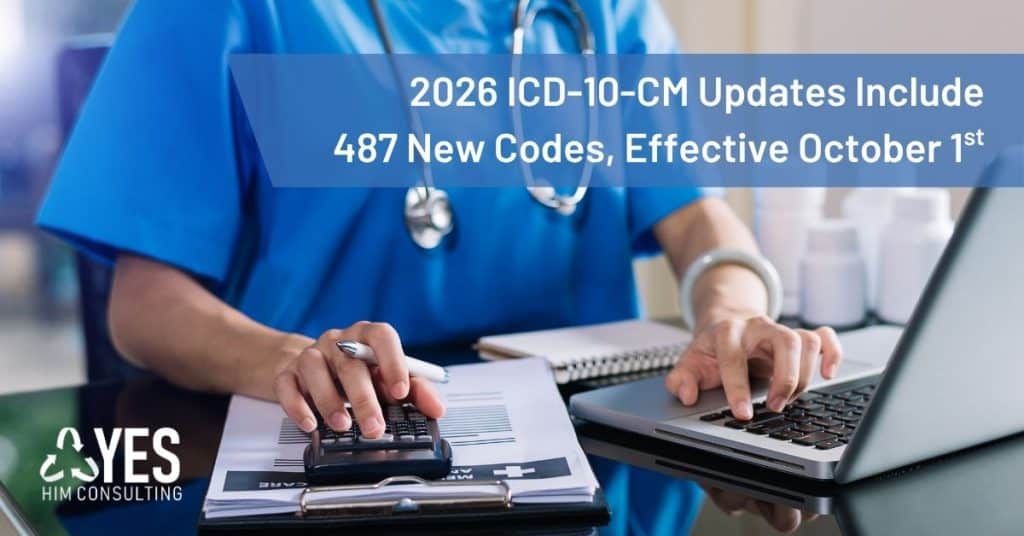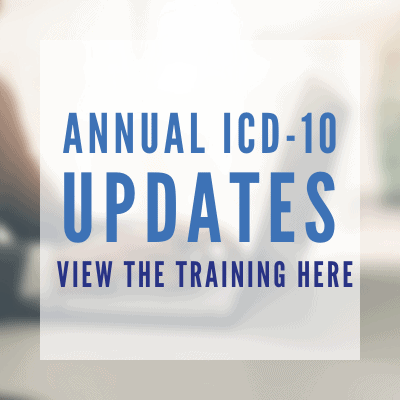2026 ICD-10-CM Updates Include 487 New Codes, Effective October 1st
2026 ICD-10-CM Updates Include 487 New Codes, Effective October 1st
The updates to the FY 2026 ICD-10-CM code set will take effect on October 1, 2025, and include 487 new diagnosis codes. The ICD-10-CM addendum with the latest codes and associated changes to the tabular list and index is available on the CMS ICD-10 code site. The updated coding guidelines are also available on this site.
YES HIM Consulting will present a comprehensive webinar outlining all the new codes and guidelines changes. Below are some of the notable changes, including guideline updates.
Chapters 12 and 19 Have the Most Number of New Codes

Most of the new codes are found in two of the chapters. There are 213 new codes in Chapter 19 for Injury, Poisoning, and Certain Other Consequences of External Causes. These include toxic and adverse effects and poisoning codes, as well as codes for baked milk and egg tolerance. But the biggest increase is due to codes for injuries involving the anatomical site of the flank; for example, contusions, bites, lacerations, puncture wounds, and other injuries. In all, this accounts for 138 new codes.
The other chapter with the largest number of new codes is Chapter 12 for Diseases of the Skin and Subcutaneous Tissue, with 116 new codes. Again, the anatomical site of the flank is involved, with four new codes for cutaneous abscess and furuncle, cellulitis, and lymphangitis of the flank. The most notable change in this chapter is the addition of 14 subcategories for non-pressure chronic ulcer sites that were not codable before. With eight codes to reflect levels of severity for each site, 112 new codes are implemented.
Between these two chapters, 329 new codes are accounted for, with 158 other codes added in other chapters. Highlights of these changes include:
Chapter 1: Certain Infectious and Parasitic Diseases
Two new codes for infestation by Demodex mites and other acariasis are available. Since Demodex mites are responsible for over 70% of all blepharitis, there are nine new codes in the diseases of the eye and adnexa that can be used, if applicable, in conjunction with the Demodex infection code.
Guidelines for HIV in this chapter have also been updated to clarify HIV disease coding, along with other updates.
Chapter 2: Neoplasms
Three new codes are available for malignant inflammatory breast neoplasm. Some minor updates to the guidelines related to antineoplastic chemotherapy and other treatments are also included.
Chapter 3: Diseases of the Blood and Blood-Forming Organs and Certain Disorders Involving the Immune Mechanism
Three new codes were added in this chapter, related to leukocyte adhesion deficiency, a rare genetic disorder.
Chapter 4: Endocrine, Nutritional, and Metabolic Diseases
This chapter has 23 new codes, including a new code for Type 2 diabetes in remission. A guideline update on this subject is also included. The remaining new codes are for distinct types of nutritional and metabolic disorders.
Chapter 6: Diseases of the Nervous System
The 10 new codes in this chapter include a code for primary progressive apraxia of speech, new codes for multiple sclerosis phenotypes, and a new code for a specific subtype of muscular dystrophy.
Chapter 7: Diseases of the Eye and Adnexa
The 17 new codes in this chapter include the previously discussed blepharitis codes, as well as codes for thyroid eye disease and neovascular glaucoma, a severe form of secondary glaucoma.
Chapter 9: Diseases of the Circulatory System
There are four new codes to represent Fontan circulation, an altered physiology from congenital heart surgery that can lead to associated complications. Guideline revisions related to hypertension with heart disease and chronic kidney disease were also included.
Chapter 13: Diseases of the Musculoskeletal System and Connective Tissue
There is just one new code in this chapter, with associated codes in Chapter 18 for Symptoms, all in reference to abnormal rheumatoid factor. There is also an addition to the guidelines for multiple sites, which mirrors the change made in the general coding guidelines.
Chapter 14: Diseases of the genitourinary system
There are five new codes in this chapter, all concerning APOL1-Mediated Kidney Disease (AMKD). There are also accompanying Z codes for genetic susceptibility and family history of AMKD.
Chapter 17: Congenital malformations, deformations, and chromosomal abnormalities
There are 23 new codes in this chapter for congenital syndromes and a new classification code with codes for neurodevelopmental disorders related to specific pathogenic variants.
Chapter 18: Symptoms, signs, and abnormal clinical and laboratory findings, not elsewhere classified
There is a total of 21 new codes in this chapter, many of which relate to other topics, such as 18 codes for flank anatomical specificity and other pain code additions, as well as a new specific code for cannabis hyperemesis syndrome.
Chapter 20: External causes of morbidity
Twenty new codes are found in this chapter, including an addition to the codes for other sharp objects entering through an orifice, fishing hooks entering through the skin, and a specific activity code for splitting wood. Other additions include codes for blast overpressure in war and military operations.
Chapter 21: Factors influencing health status and contact with health services
Twenty-six codes were added in this chapter: some related to other topics, such as genetic susceptibility and family history for certain conditions. Also included are codes that allow for the reporting of prophylactic removal of fallopian tubes and exposure to Diethylstilbestrol (DES). Three new social determinants of health (SDOH) codes for utility insecurity are also added.
YES HIM Consulting to Present A Comprehensive Review of 2026 ICD-10-CM Changes
The synopsis above includes some of the highlights of the October 1, 2025, changes for diagnosis codes. Keep an eye out for an in-depth review of all of the changes coming for FY 2026 in our soon-to-be-released online course.
Read our summary of the 2026 ICD-10-PCS updates. For more information on the ICD-10 updates, review our ICD-10 Coding Resource Center.



